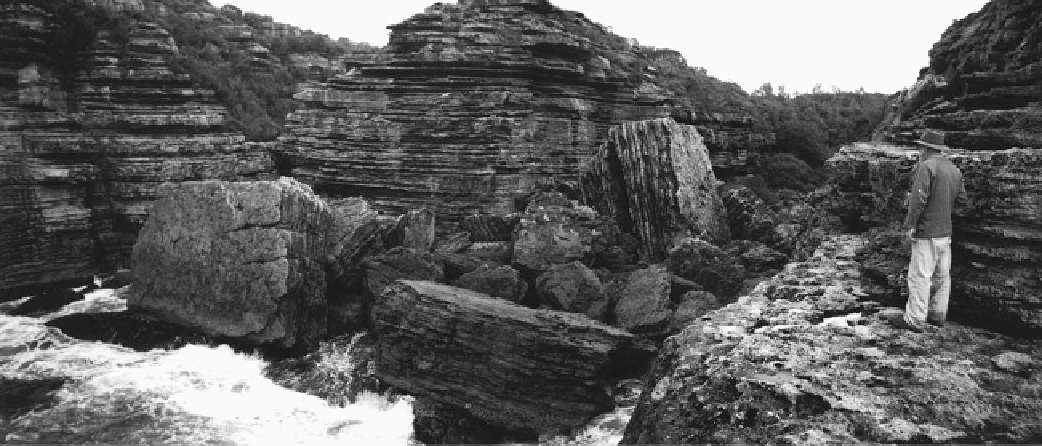Geoscience Reference
In-Depth Information
Fig. 9.14
Boulder pile blocking the mouth of Mermaids Inlet, New
South Wales, Australia. The largest blocks are more than 5 m in
length. The gulch on the right contains a shelly beach dated at
1790 ± 70 radiocarbon years BP
9.5.5
An Event in the Kimberley, Western
Australia
centuries. The paintings typically show a clown-like face
painted white surrounding by an outer, barbed red halo that
represents lightning (Fig.
9.16
). They are without a mouth
and their nose indicates where the power flows down
(Mowaljarlai and Malnic
1993
). The Wandjina are the rain
spirits of the Wunambul, Wororra, and Ngarinyin language
people (Layton
1992
). The Wandjina have great power and
are associated mystically with creation and flooding rain.
Wandjina do not have a mouth because their knowledge is
beyond speaking. Were they to have a mouth, floods would
be generated that would drown the whole Earth. Their
origin may be much older and traceable to the flood myths
in the Dreamtime. Although linked to the annual monsoon,
the Wandjina depict something much more intense. Paint-
ings of the Wandjina may be representations of a comet. Far
from the modern perception of comets being white and
consisting of a nucleus and a single curved tail, comets can
take on many shapes and colors (McCafferty and Baillie
2005
). For instance, a comet can form two tails, giving it the
appearance of a figure with long flowing hair on two sides.
The area around the nucleus can also fragment into many
different shapes. Compare the Wandjina rock painting in
Fig.
9.16
to that of Comet Donati of 1858 in Fig.
9.17
. The
resemblance is striking. Comet Donati developed a human-
like head with eyes centered on its nucleus or nose. The
nose in the Wandjina painting in Fig.
9.16
even looks like a
comet. Just like the Wandjina, Comet Donati did not have a
mouth. The Wandjina paintings are probably not of Comet
Donati, but their resemblance to it suggests that they are
comet paintings. One Aboriginal legend tells about a flood
that was brought on by the 'star with trails' (Mowaljarlai
and Malnic
1993
). The Wandjina caused a great flood that
A similar, but even larger, cosmogenic event to that
described along the New South Wales coast occurred along
the Kimberley coast of Western Australia (Fig.
9.11
d).
Again the event is supported by Aboriginal legends (Mo-
waljarlai and Malnic
1993
; Hamacher and Norris
2009
).
Curiously, when Europeans made contact with Aboriginal
coastal tribes in Western Australia, they noted that the
Aborigines avoided the coast and made little attempt to use
it for food, even though there was evidence of past usage in
the form of large shell kitchen middens. The coast appeared
to have been abandoned. Legends about tsunami are most
notable around Walcott Inlet (Fig.
9.11
d). They recount a
very fast flooding from the ocean that filled this inland tidal
body for up to 12 h. Other myths imply that water flooded
to the top of 500 m high mesas surrounding this inlet. The
flooding was extensive from Walcott Inlet in the south, to
Kalumburu in the north, and to Kununurra in the east. There
is also the intriguing naming of Comet Rock at Kalumburu
(Fig.
9.15
). Here, not only does the rock look like the head
of a comet with an extending trail; but there is also an
Aboriginal rock drawing on the lower face of the rock that
mimics the form of the rock and is orientated parallel to the
rock feature. This rock is orientated 310 to the NW,
matching the direction of approach of mega-tsunami on the
coast to the west.
Most intriguing are the Wandjina rock art paintings and
their associated interpretations (Crawford
1973
; Layton
1992
; Mowaljarlai and Malnic
1993
). Wandjina paintings
are stylistic across the Kimberley. None is older than four

